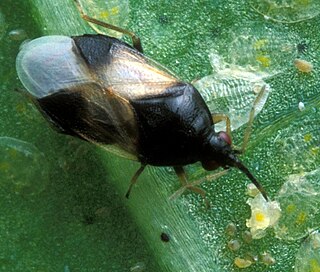
Aphids are small sap-sucking insects and members of the superfamily Aphidoidea. Common names include greenfly and blackfly, although individuals within a species can vary widely in color. The group includes the fluffy white woolly aphids. A typical life cycle involves flightless females giving living birth to female nymphs—who may also be already pregnant, an adaptation scientists call telescopic development—without the involvement of males. Maturing rapidly, females breed profusely so that the number of these insects multiplies quickly. Winged females may develop later in the season, allowing the insects to colonize new plants. In temperate regions, a phase of sexual reproduction occurs in the autumn, with the insects often overwintering as eggs.

The Hemiptera or true bugs are an order of insects comprising some 50,000 to 80,000 species of groups such as the cicadas, aphids, planthoppers, leafhoppers, bed bugs and shield bugs. They range in size from 1 mm (0.04 in) to around 15 cm (6 in), and share a common arrangement of sucking mouthparts. The name "true bugs" is often limited to the suborder Heteroptera. Many insects commonly known as "bugs", especially in American English, belong to other orders; for example, the lovebug is a fly and the May bug and ladybug are beetles.

Anthocoridae is a family of bugs, commonly called minute pirate bugs or flower bugs. Worldwide there are 500-600 species.

Myzus persicae, known as the green peach aphid, greenfly, or the peach-potato aphid, is a small green aphid. It is the most significant aphid pest of peach trees, causing decreased growth, shrivelling of the leaves and the death of various tissues. It is also acts as a vector for the transport of plant viruses such as cucumber mosaic virus (CMV), potato virus Y (PVY) and tobacco etch virus (TEV). Potato virus Y and potato leafroll virus can be passed to members of the nightshade/potato family (Solanaceae), and various mosaic viruses to many other food crops.

Orius insidiosus, common name the insidious flower bug, is a species of minute pirate bug, a predatory insect in the order Hemiptera. They are considered beneficial, as they feed on small pest arthropods and their eggs. They are mass-reared for use in the biological control of thrips.

Anthocoris is a genus of minute pirate bugs in the family Anthocoridae. There are at least 30 described species in Anthocoris.

Anthocoris nemoralis is a true bug in the family Anthocoridae. The species is native to Europe and is introduced in North America. It is a predator of aphids, spider mites and jumping plant lice, and is therefore used as a biological pest control agent.
Colophina clematis is a species of aphid in the woolly aphid subfamily, Eriosomatinae, native to Japan. This woolly aphid has the distinction of being the first species of aphid to have been identified as having a "soldier" caste. First instar nymphs of this type are able to protect the aphid colony, killing the larvae of predatory ladybirds, hoverflies and the flower bug Anthocoris nemoralis.

Anthocorini is a tribe of minute pirate bugs in the family Anthocoridae. There are about 7 genera and at least 30 described species in Anthocorini.

Tetraneura ulmi, the elm sack gall aphid, is a species of aphid in the family Aphididae.

Tetraneura is a genus of woolly and gall-making aphids in the family Aphididae. There are at least 30 described species in Tetraneura.

Temnostethus gracilis is a species of minute pirate bug in the family Anthocoridae. It is found in Europe and across the Palearctic to the Caucasus and Siberia and North America.
Anthocoris musculus is a species of minute pirate bug in the family Anthocoridae. It is found in Europe & Northern Asia and North America.
Anthocoris antevolens is a species of minute pirate bug in the family Anthocoridae. It is found in North America.

Xylocoris galactinus is a species of bugs in the family Lyctocoridae. It is found in Europe & Northern Asia, North America, and Oceania.
Anthocoris tomentosus is a species of minute pirate bug in the family Anthocoridae. It is found in North America.
Heteropeza is a genus of gall midges and wood midges in the family Cecidomyiidae. There are about six described species in Heteropeza.

Anthocoris confusus is a species of minute pirate bug in the family Anthocoridae. It is found in Europe & Northern Asia and North America.
Lasiochilidae is a family of bugs, formerly classified within the minute pirate bugs of the family Anthocoridae.

Tamalia is a genus of aphids in the family Aphididae. There are about six described species in Tamalia.













